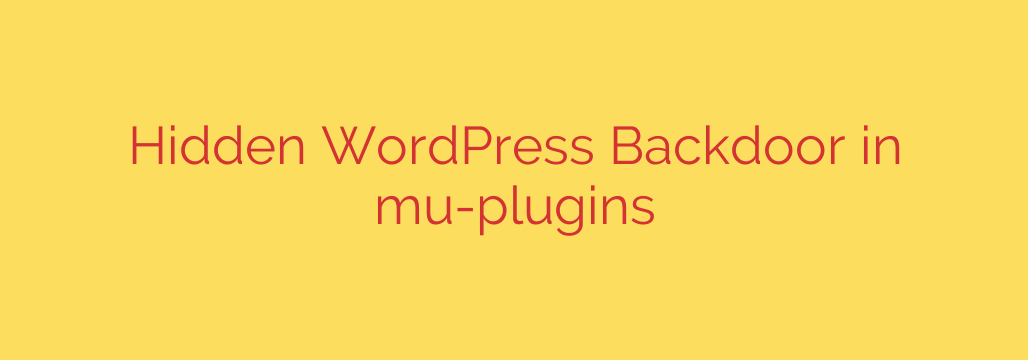
Uncovering the Hidden WordPress Backdoor in Your mu-plugins Directory
For many WordPress administrators, security is a top priority. You keep your plugins updated, use strong passwords, and maybe even run a security scanner. But what if a backdoor was hiding in a place you never thought to look? A sophisticated new attack is leveraging a little-known but powerful feature of WordPress: the Must-Use Plugins directory.
This type of malware is particularly dangerous because it’s designed for stealth. It can create hidden administrator accounts, inject spammy links, and compromise your site, all while remaining completely invisible from your WordPress admin dashboard.
Here’s what you need to know about this threat and how to protect your website.
What Are mu-plugins and Why Are They a Target?
First, let’s clarify what mu-plugins are. The “mu” stands for “Must-Use.” Any plugin placed in the wp-content/mu-plugins/ directory is automatically activated across your entire WordPress site.
Key features of mu-plugins include:
- They are always active and cannot be disabled from the WP admin area.
- They don’t show up in the standard “Plugins” list.
- They load before regular plugins, giving them priority.
While developers use this feature for essential site-wide functionality, hackers exploit mu-plugins for their persistence and invisibility. By placing a malicious file here, they ensure their code runs constantly without alerting the site owner through the normal admin interface.
The Anatomy of a Deceptive Backdoor Attack
This isn’t a simple piece of malware. It’s a multi-part attack designed to evade detection at every turn. Here’s how it typically works:
The Initial Loader: The attacker places a small, seemingly innocent PHP file inside your
wp-content/mu-plugins/directory. This file, often called a “loader,” contains just one or two lines of code. Its only job is to load the main malicious payload from another location.The Hidden Payload: The loader file will point to the real malware, which is hidden deep within your WordPress core files, often in a directory like
wp-includes. Attackers use deceptive file names to blend in, naming the malware something likeclass-wp-user-query.phpto mimic a legitimate WordPress file.Advanced Evasion Tactics: To make the attack even harder to spot, hackers use several tricks:
- Hidden Files: The malicious payload file is often created as a “dot-file” (e.g.,
.class-wp-user-query.php). On Linux-based servers, files starting with a dot are hidden from standard directory listings. - Code Obfuscation: The code inside the malware is heavily obfuscated using functions like
base64_decodeandgzuncompress. This makes it unreadable to a human who might accidentally open the file. - Cookie-Based Triggers: The malware often checks for a specific cookie in the visitor’s browser. If the cookie isn’t present, it injects the spam or pop-ups. Crucially, it avoids doing this for logged-in administrators, meaning the site owner will never see the malicious activity while they are working on their own site.
- Hidden Files: The malicious payload file is often created as a “dot-file” (e.g.,
Once active, this backdoor typically creates a new, hidden administrator user, giving the attacker full control over your website to inject content, redirect traffic, or steal data.
How to Find and Remove This Hidden Malware
Because this threat doesn’t appear in your admin dashboard, you have to do some manual checking.
Step 1: Inspect Your mu-plugins Directory
Using an FTP client or the File Manager in your hosting control panel (like cPanel), navigate to wp-content/mu-plugins/. This directory often doesn’t exist on a standard WordPress installation, so if you see it, inspect its contents carefully. If you didn’t create the files inside, they are highly suspicious.
Step 2: Hunt for Hidden and Suspicious Files
Next, check your core folders like wp-includes and wp-admin. Make sure your FTP client or File Manager is set to “Show Hidden Files.” Look for any files that don’t belong, especially those starting with a dot or with names that are slightly different from legitimate core files. If you find a suspicious file referenced by the loader in mu-plugins, you’ve likely found the payload.
Step 3: Audit Your WordPress Users
In your WordPress dashboard, go to Users > All Users. Look carefully for any administrator accounts that you don’t recognize. Attackers often give these accounts common names like “admin,” “support,” or “backup” to avoid suspicion.
Step 4: The Cleanup and Hardening Process
If you’ve found evidence of a hack, follow these steps immediately:
- Delete the malicious loader file from the
wp-content/mu-plugins/directory. - Delete the hidden payload file from its location (e.g., inside
wp-includes). - Delete the unauthorized administrator user from your WordPress dashboard.
- Run a full scan with a reputable security plugin (like Wordfence or Sucuri Scanner) to find any other backdoors or infected files.
- Change all your passwords, including WordPress admin users, FTP accounts, and your hosting database password.
Proactive Security: How to Prevent Future Attacks
Cleaning up a hack is stressful. Preventing one is much better. Implement these security best practices to harden your site against this and other threats.
- Regularly Monitor Your File System: Make it a habit to periodically check your
mu-pluginsdirectory and other core folders for any unfamiliar files. - Use a Trusted Security Plugin: A good security plugin can monitor file changes, scan for malware, and block brute-force attacks, providing an essential layer of automated protection.
- Enforce Strong Password Policies: Ensure all users, especially administrators, use long, complex, and unique passwords.
- Update Everything, Always: Keep WordPress core, your themes, and all your plugins up to date. Updates often contain critical security patches.
- Harden Your WordPress Installation: Take extra steps like disabling the plugin and theme file editor from the admin dashboard and ensuring correct file permissions are set on your server.
By understanding how attackers exploit lesser-known features like mu-plugins, you can stay one step ahead. Don’t wait for a disaster—take a few minutes today to check your directories and ensure your site remains secure.
Source: https://blog.sucuri.net/2025/07/uncovering-a-stealthy-wordpress-backdoor-in-mu-plugins.html








